
Engage with specialized UPSC Geography Optional Mains Topic Wise Questions focused on Models, Theories, and Laws in Human Geography. Explore the theoretical frameworks and conceptual models crucial for understanding human-environment interactions, essential for UPSC mains preparation. Each question is meticulously tailored to deepen comprehension and analytical skills, covering a spectrum of geographical theories, models, and laws. From central place theory to gravity models, aspirants gain profound insights into the diverse perspectives shaping human geography. With detailed explanations and structured content, this resource serves as an invaluable aid for mastering theoretical principles in human geography, vital for success in the UPSC examination. Whether you’re a newcomer or seasoned aspirant, immerse yourself in Models, Theories, and Laws in Human Geography to enrich your UPSC Geography Optional Mains journey and excel in your examination preparations.
Contents
- 1 Q1. Discuss Von Thunen’s model of agricultural land use and examine if the model is applicable to India. (1994)
- 2 Q2. Dualism in Geography. (2007)
- 3 Q3. Give an account of the functional basis of central place hierarchy. (2007)
- 4 Q4. Discuss Weber’s theory of Industrial location, and asses its relevance in the present day context. (2005)
- 5 Q5. To what extent are the heartland and rimland theories helpful in understanding the world political situation today? Express your opinion clearly. (2004)
- 6 Q6. Critically examine the stages of Economic Growth Model propounded by Rostov. Illustrate your answer with suitable examples. (2003)
- 7 Q7. To what extent do the regional patterns of economic development and human development in the world correspond with each other? Highlight situations of departure, in particular. (2002)
- 8 Q8. Bring out the main points of difference between the central place theories of Christaller and Losch. (2002)
- 9 Q9. Discuss the concept and application of system analysis in Human Geography. (2001)
- 10 Q10. Examine the theories about population control and explain the relative merits of these theories in limiting population growth. (1995)
- 11 In case you still have your doubts, contact us on 9811333901.
Q1. Discuss Von Thunen’s model of agricultural land use and examine if the model is applicable to India. (1994)
Answer:
An attempt to analyse the locational pattern of agriculuture was first proposed by J.H. Von Thunen. In his work ‘Der Isolierte Staat’ in 1826, his model adopted a partial equilibrium approach designed to explain the type of agriculture production that would be best carried out at a given location i.e. it is deterministic and normative.
Presumptions: Thunen’s main aim was to show how and why agricultural land use varies with distance from the market. His model seeks to simplify the real world situation by making a set of assumptions.
- Existence of a large isolated state cut off from the rest of the world.
- Centrally palced large city as sole urban market.
- Homogenous physical environment (plan terrain with equal fertility).
- No improved means of transport except peasant waggon and means of transport and roads are of equal quality.
- The transport costs are directly proportional to weights and distances.
- The maximizing of profit by all farmers who adjust the output of corps to meet the needs of central market.
- Equal labour cost everywhere.
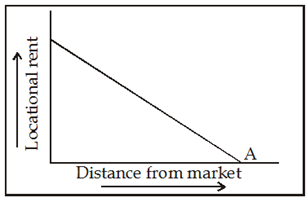
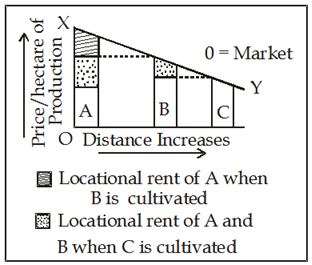
Thunen’s methodology, for the explanation of his model is an advent in the location theory. His theory is based on the concept of economic rent which is basically a measure of the advantage of one piece of land over another. In his assumed conditions of uniform plain and equal production cost, the only advantage a piece of land can have over another is its location in relation to the market for agricultural products. Hence the term locational rent in used.
Thunen’s locational rent is the key factor sorting the uniform area of his isolated state into district land use zones. The locational rent can be calculated by using the following formula:
L = y (m – c) – y fd
WhereL = location rent per unit of land
Y = yield per unit of land
m = market price per unit of product
c = production cost per unit of product
f = Transport rate per unit of distance
d = distance of land from the market
For a particular crop, if yield y = 1000 tonnes\km2, Price m = 100 $\ton, Production cost c = 50$/ton, Transport rate f = 1$=ton/km, the locational rent at the city centre would be (here d = 0)
1000 (100 – 50) – 1000 × 0 × 1 = 50,000 $\km2
At the distance of 25 km it would be 25000$/ km2 at the distnace of 50 km it would be 0 and beyond that it would get a loss.
The market price being the same and the price obtained at the market being the same, the location rent would be higher near the city since the transportation cost will be less here. At a greater distance from the market a one can not afford to intensify the production with additional inputs and costs because the higher yields would incur a greater transportation cost at this distance offetting the returns from higher yields. More extensive cultivation is better away from the market since it can be done at lower cost. Thus the intensity of cultivation decreases away from the city as has been shown in the given figure here:
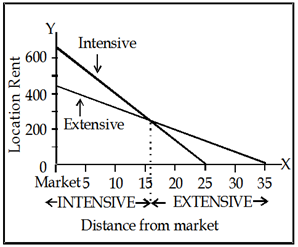
In reality, market price, perishability, bulkiness, yields and production costs usually vary between different products. According to Thunen’s model, the landuse varies with distance from the market. A simplified example of land use zonation can be shown by the following bid price curves for three distinct type of land uses which have slope of different steepness according to their locational advantage and nature of the product, i.e. bulky or light or perishable.
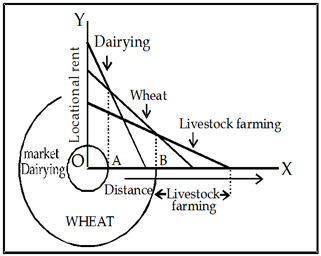
In the given figure, land use boundaries occur at intersection of bid-price curves. Under the given circumstances, dairying would be most profitable between O and A, wheat between A and B and so on. By rotating the axis OX at the intervals of A, B and C, a concentric zonation of land use results.
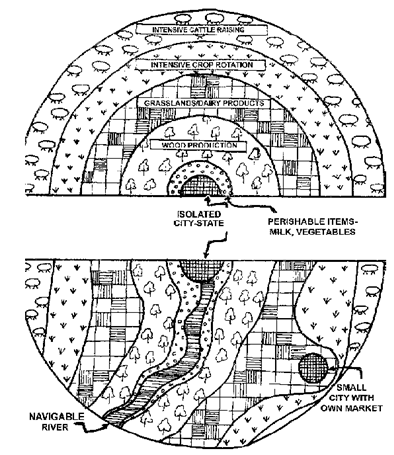
In this way, Von Thunen suggested that the value of land and hence its rent would decrease away from the city as transportation cost increases. Thus, based upon his presumptions and principles, Thunen envisaged that the agricultural land use pattern would comprise a series of six concentric zones around his ideal town, as shown in the figure given here.
Zone I: Market gardening and milk production-Perishable items milk and vegetables would be produced near the market (town) due to:
(a)slowness of transportation,
(b)absence of refrigeration (at that time), and
(c)high prices for these items in the town.
Zone II: Firewood and lumber production – At that time firewood was the main source of fuel and forestry yielded greater returns after market gardening.
Zone III: Grain farming without fallow and pasture land.
Zone IV: Grain farming with fallow and pasture land.
Zone V: There field system (33% fallow land)
Zone III, IV and V are devoted to grain farming and other crops differentiated by decreasing intensity of cropping.
Zone VI-Livestock farming: Here livestock farming outweighs greater transport cost because livestock could be driven to market with almost no transportation cost and their secondary products butter and cheese are not so much perishable.
Von Thunen later modified his model of land use zones by the presence of a navigable river and a satellite town with its own marketing area. As the navigation is cheaper than road, the land use zones would tend to develop along the navigable river. However, in reality several such modifying factors exist, making the land use pattern more complex.
Applicability in India: In north Indian plains, in both villages and towns, the cropping belt are found. The highly fertile and adequately manured lands around the village settlement\ towns are devoted to perishable and more fertility requiring crops, e.g.–vegetables, potatoes and orchards.
In the land lying in the middle belt, crops like rice, wheat, gram, pulses, maize, barley, sugarcane etc. are grown, subject to texture, drainage and other properties of the soil. In the outer fringe, fodder crops and inferior cereals (bajra and millets) are mainly sown.
However, hardly any concentric zonation is found in Indian land use pattern. The Thunen’s model finds lesser applicability in India because of the fact that mainly subsistence farming is done here. Other factors which distort the concentric pattern are:
- Introduction of irrigation, especially tubewells
- consolidation of holdings
- Introduction of package programme
- Improved and fast means of transport
Q2. Dualism in Geography. (2007)
Answer:
The dualism in geography is as old as geography as a discipline itself. Though its perspectives have been changing over the years but dualism has not. The dualism is also known as dichotomy. In the delineation of the sphere of geography and the methodology to be adopted for its study, there has existed and still exist significant dualism and dichotomies such as systematic versus regional geography, physical versus human geography, deterministic versus possibilitic geography etc.
During the period of prehistory of geography, an obscure and vague dualism can be found in the writings of the Greek, Roman and Arab geographers. Dualistic thinking became more conspicuous during the post – renaissance period in Europe. Since then dualism in geography seems to have been visible into a number of mutually exclusive branches. These dichotomies or branching of the subject looks quite logical. Geography is an integrative science and hence there is a debate over which branch and which methodology should be given central focus in geography. In the words of P.E James, acceptance of many dichotomies, is a semantic trap. The dualism of topical versus. regional, physical versus human, determinism versus possibilism, ideographic versus nomothetic, formal sites versus functional locations are not mutually contradictory, such as good and evil. All these dichotomies and dualisms have done considerable damage to geographical thinking. These dualisms have projected the various approaches in geography as being contradictory to each other which, in reality, are complementary or a subordinate part of the other.
Some of the most prominent dualisms are the following:
Physical Geography versus Human Geography.
General Geography versus Regional Geography.
Determinist Geography versus Possibilists Geography.
Historical Geography versus Contemporary Geography.
Q3. Give an account of the functional basis of central place hierarchy. (2007)
Answer:
The central place theory was given by Christaller with a view to analyse the spatial organisation and sequential, hierarchal and orderly distribution of different settlements in a given landscape. It seeks to orgnise the hierarchy of both the urban and rural settlements.
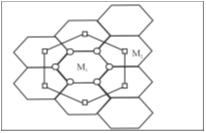
The central place theory advocates that services centres and settlements providing one or more services tend to be located in the centre of the area served. As stated above, it was developed by Walther Christaller in 1933 from the study of towns in South Germany . It states that there is a tendency for services centres to be dispersed over the region in uniform pattern. He proposed that settlements of a given rank are equally spaced and surrounded by a hexagonal shaped services areas or hinterlands.
The basic postulates of this theory are:
- the principle of central places i.e. the primary core area of surrounding region,
- the principle of centrality i.e. the surplus of goods and services that central place offers to surrounding region,
- the principle of hierarchy, which is dependent upon centrality,
- the principle of vesting i.e. typical pattern of region,
- the principle of optimality and efficiency criteria – this forms the basis for other above mentioned four principles.
Out of all these principles, the principle of central place hierarchy assumes primary importance. The Hierarchy of Central place and its surrounding region is based upon the range of goods and services that central place offers to its surrounding region. The higher the range of any goods or services, the higher would be the rank in hierarchal order. For this, Christaller has primarily used three criteria (i) the Marketing Principle, (ii) Transportation Principle and (iii) Administrative Principle.
Based on Marketing principle, the core region i.e. central place covers around one-third area of surrounding region. In this diagram, M1 is the first level hierarchy and M2 is the second level hierarchy. There the centrality of M1 captures one-third region of each M2 region and hence it gets a hexagonal shape.
Based upon Transportation principle, the theory assumes that M1 will assume one-half region each of M2, therefore(See figure)
M1 = M2
In this figure, the centrality of M1, capture one-half of complementary area of M2.
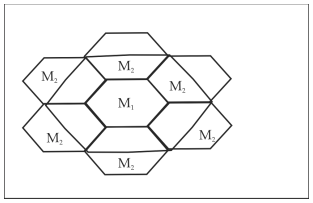
On the basis of principle of Administration, the centrality is much higher as it provides administrative services to all the surrounding regions. It captures all the complementary area of each second order region. Here the K = 7
(See figure)
In this figure, the centrality of M1 is assuming entire complementary area of each M2 region.
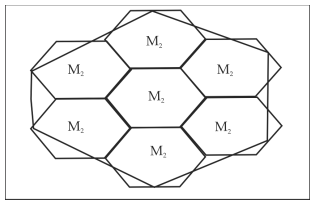
However, there are certain limitations of this theory which are as follows:
The assumption regarding ‘Isotropic Surface’ is never fulfilled.
Fixed value of K of Christaller’s model has poor approximation with reality.
‘Industrial Concentration’ and ‘Government policies for regional development’-affect the model.
Transportation routes and irregular landforms disrupt Christaller’s hexagonal pattern.
He did not take into account the impact of ‘urbanisation’ and ‘industrialisation’ Rural-urban-fringe, ‘dormitary settlements’, bastis, slums, etc.
This theory, though assumes all the fallacies associated with a normative, deductive model, still, it is a landmark theory in analyzing the range of any central place in comparison with its surrounding region.
Christaller’s model is not reduntant and can be used as yardstick to compare local deviations.
Q4. Discuss Weber’s theory of Industrial location, and asses its relevance in the present day context. (2005)
Answer:
Weber’s theory is based on the ‘least cost principle’ which is used to account for location of manufacturing industry. Weber’sapproach is deterministic and normative.
Weber aims to explain the location of industrial activity in terms of three economic factors:
- Transport costs
- Labour costs
- Agglomeration economies
His explanation is based on finding the least cost point for production.
Assumptions: The main assumptions are as follows:
- The unit of analysis is a single, isolated country that is homogenous in terms of climate, topography, race of people, technical skills of the people and is under one political authority.
- Transport costs are a function of weight and distance increasing in direct proportion to length of shipment and weight of cargo.
- Costs of land, building equipment, interest and depreciation of fixed capital do not vary.
- The size and location of centres of consumption of the industrial products are given. The markets, thus, are point on the plain.
- There is an uneven distribution of natural resources on the plain. The location of sources of raw materials are assumed to be known.
- Labour is geographically fixed.
- The entrepreneur’s seeks to minimise the total cost of production.
- Conditions of perfect competition exist whereby resources and markets are unlimited at their given locations and no firm may obtain a monopolistic advantage from its choice of loacation.
Principles: Weber’s analysis of industrial location is divided into two major sections:
- Indentification of the point of minimum transport costs
- A discussion of the circumstances under which production will be attracted away from this least cost point
(A) Least Cost Location Principles: According to Weber there are three regional factors which affect the costs of production:
- The cost of raw material.
- The cost of transporting raw material, and
- The cost of labour
The cost of raw material varies according to the nature of the deposits and the difficulty of mining them.
If the deposits are difficult to access and they have great overburden then the cost would naturally be higher. Onthe countrary shallow deposits, which will be less difficult to mine, will have lower prices.
The cost of transporting raw materials depends on the nature of the raw materials, i.e. whether it is-
- Ubiquitous: One that is found everywhere such as water, air, clay etc.
- Fixed: One that is found in a particular place,i.e. has a fixed location.
- Pure: Localised materials that enter with their full weight into the finished product.
- Gross: A localised material that implies only a portion of, or none of their weight to the finished products. Fuel is an extreme type of gross material, for none of its weight enters into the product.
All these variations are reflected in the cost of transportation so that regional factors affecting production are reduced to transport cost and labour cost.
He identified another local factor called agglomeration or deglomeration economies. Agglomeration economies refer to savings of the individual plants that result from their operating in the same location. This might result from the common use of such activities as auxiliary industries, finacial services, public utilities etc. In a single firm location, these processes and services have to be carried out or borne by the firm at a greater cost individually. As more and more firms cluster, linkages increase and there is increased flow of goods between plants, development of specialised labour force and savings due to bulk purchasing of materials and large scale marketing of products. Agglomeration economies can be attained when a firm increases its production or when many firms cluster together.
Least Transport Cost Point: In the absence of spatial differences in basic production costs, Weber observed that manufacturing plants will located at the point where the total transport costs are minimised. He sugggested that transportation costs are, in effect determined by two
factors:
- The weight ofthe materials to be assembled together with the weight of the final product to be shipped to the market.
- The distances over which the materials and the product have to be moved.
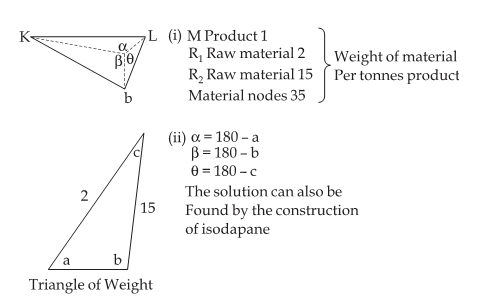
The combination of these two elements results in a simple index of cost, the tonne-km or tonne miles. The location problem is then, simplified to find the point-where the total tonne mileage is minimisedfor the particular production- distribution process.
To find the least transport cost location; Weber used simplified locational traingles, assuming two points where raw materials and a single market are found. From this locational triangle, angles a, b and c can be found.
In order to find out whether industries are market oriented or raw material oriented, Weber devised a simple Material Index(MI) formula.
MI = Weight of the localised materials used in the industry.
Weight of the product.
When there is no weight loss in the production, the material index equals 1,while when there is substantial weight loss the material index is higher than 1.
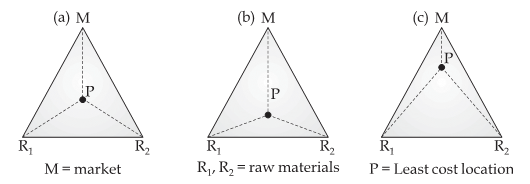
Case A. One market and one raw material: In first case a raw material is to be produced at a different location (R) and the finished product made of material is to be consumed at a different location (M). The problem is to determine the location where the manufacturing or processing is to take place. There are several
possibilites:
- If the raw material is ubiqutous, then the factory will be located at the market since at this point the lowest transport costs would prevail on both material and product.
- If the raw material is fixed then the factory can be located in either the market or at the source of the raw material.
- If the raw material is fixed and gross, then the factory will be located at the source of raw material.
Case B.One market and two raw materials: The second case assumes that raw materials are available at two place R1 and R2 at equal prices and the finished product is to be consumed at M.
- If both R1 and R2 are ubiquitous then the manufacturing will be at the market since at this point the transport costs on both,material and product are the lowest.
- If both raw materials are fixed and gross, the solution is complex. Weber sought to achieve this by the application of his locational triangle.
- If both the raw materials R1 and R2are fixed and pure then the factory will be located at the market.
- If R1 is ubiquitous and R2 is fixed elsewhere than at the market and if both are pure, then the manufacturing will be at market.
Role of labour: If at some other place in the region, the costs of labour per unit of product is less than it is at the optimum transport location, perhaps because an established industry closed down or an unusually high rate of population growth occurred or a pool of particularly skilled workers is available and if the increment to transport costs at this alternative location is less than the labour savings, a deviation from the ‘optimum’, least transport cost location will arise.
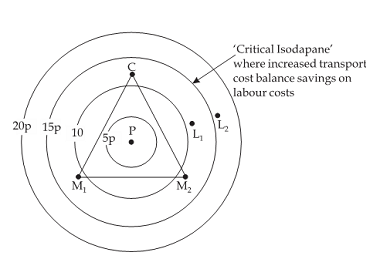
Role of agglomeration: The coming together or agglomeration of industries often cuts in production costs if two or more industries oprate in the same location.
Weber’s theory identifies certain basic influences on industrial location. It is opento criticism. Its value is now limited- partly because of certain inherent weaknesses in the theory and partly because circumstances have changed since the turn of the century, when Weber published it.
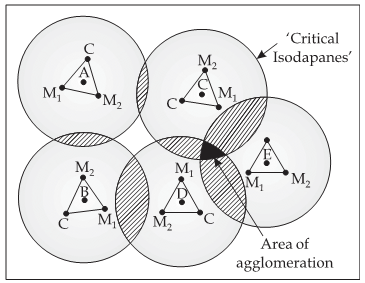
1. Many of the assumptions made by Weber are quite unrealistic
Perfect competition rarely exists.
Man does not always behave rationally.
The market is in the form of points and one plant serves only one market.
2. Weber’s material index was too crude a measure of transport cost which do not rise proportionately with distance and weight. Moreover, transport
costs are rarely a basic criteria for the location of a firm today.
3. Weber concentrated too much on minimising costs.
4. Weber’s concept of the nature of industrial organisation and its decision making process is inconsistent with the conditions in the modern industrial world.
5. Increased complexity of industrial organisation as the single product, one factory, private firm is replaced by multi product, International corporation. In this condition Weberian theory is diffcult to apply. Now manufacturing is more complex than it was in the early 20th centruy. Many plants begin with semi-finished items and components rather than with raw materials.
Q5. To what extent are the heartland and rimland theories helpful in understanding the world political situation today? Express your opinion clearly. (2004)
Answer:
The geographic relationship of politics in this world, having the popular nomenclature of Geopolitical World Views, have been a subject of continuing interest among scholars. While scholars of the earlier generation had been attempting to explain the pattern of political structure in the world in terms of local and regional variations in environmental conditions, the new thinkers like Mackinder and Spykman, attempted to describe and explain world political patterns in terms of spatial models of world power, based on some principal (fundamental) causes inherent in history and geography. It is partly because of this reason and partly because of the fact that modern states (nations) believed tham to be true, the heartland and rimland theories given by Mackinder and Spykment will hold some relevance, though in altered form and to a variable degree of extent, in understanding the world political situation today.
Before discussing the relevance of these theories, it is imperative to examine these theories in brief:
Heartland Theory: Sir Halford Mackinder (1861-1947) theory has perhaps been the best known global strategic scheme in modern times. He give his theory for the first time in 1904 and later on modified it several times. His Heartland theory regards political history as a continuous struggle between land and sea powers with the ultimate victory going to the continental power.
As per this theory, the continental power was represented by the world island consisting of Eurasia and Africa (comprising 7/8th of total world population and 2/3rd of total land area). Mackinder’s Heartland located in interior and Arctic drainage in inner Eurasia was perceived as the greatest natural fortress surrounded by mountains on three sides and by ice-bound Arctic on the fourth, as shown by the figure given here.
Thus the heartland was not accessible to sea powers. It was however, vulnerable to land forces in the southwest, through eastern Europe, between the Ural mountains and the Caspian Sea only. With its vast industrial and agricultural resources, the Heartland could conquer Europe, the Middle East, India and Far-East. The other landmasses could follow later. These landmasses included the following:
Inner or Marginal Crescent: The rest of Europe, India, S.E. Asia and much of China.
Outlying Islands or Outer Crescent: North and South America, Australia, Africa, South of Sahara, the island regions of Britain and Japan.
Mackinder modified his Heartland theory in 1943 in which he described the geostrategic area comprising the North Atlantic Ocean, eastern US and western Europe, as the “midland basin”. He regarded this areas as an effective counterbalance to the emerging political power potential of the Eurasian Heartland.
Although Mackinder has been the greatest influence on global strategic thinking in the modern times, he has been variously criticised, as given below:
(i) Mackinder oversimplified history in a rather deterministic fasion as a struggle between land and sea power.
(ii) He wrongly equated power potential with sheer geographical area.
(iii) He failed to appreciate the airways as new form of mobility.
With the rapid march of science and technology, especially the development of war planes, missiles, nuclear weapons, etc. the surface configuration of the earth has become very much less isgnificant politically. However, the 2nd world war also raw the rise of Soviet Union as the strongest poer in Eurasia. Soviet Union soon began to be looked upon, in terms of the Mackinder’s thesis, as a colossus, controlling the fortress and threatening to sweep over the rest of the world. Whatever its short comings, the Heartland theory continued to be relevant to the post-1945 bipolar world politics, because the parties to the game of power continued to have faith in it. deep seated faith in the Heartland theory was at the root of the policy of nuclear detterrence and massive arms built up by both the parties.
The current turbulence in the global political system, most particularly, the collapse of Soviet Union, followed by armed American intervention in the Gulf, Afghanistan and Iraq and consequent riseof terrorism as a global menace has made the world of international politics very complex. Super-predominance of United States in world affairs is unquestioned. Mackinder’s theory through gave more weightage to Heartland region, it loosely/tacitly recognised the potentiality of US-European block in his modified concept of ‘midland basin’. Moreover, several poles having different currencies of power can be visualized, eg., military (US and Russia), economic and financial (European Union and Japan) demographic (China and India)—and the political situation today and in the future, shall, in all likelihood, depend on how the different poles cooperate with one another.
Besides, the collapse of Soviet Union has by no means written of the Heartland region as a major player in international politics. The economy of Russia is on a sould path of rapid revival (booming!) in 2003-04 and the C.I.S., by virtue of its resource endowment, geographical location and economic and military power (a legacy of super power era), is destined to remain a leading force in world politics.
Apart from that, the US in particular is facing the deadly threat of terrorism which can be fought alone by US. The Iraq quagmire has also weakened the position of US in terms of ‘Idealpolitilk’.
Rimland Theory: Professor Nicholes J. Spykman (1893-1943), working from the same premises as Mackinder, gave a very different inter-pretation of the relative importance of the heartland vis-a-vis the surrounding tier, the Inner or Marginal Crescent-party continental and partly oceanic, which he named as the Rimland.
The Rimland theory says that national power is the final determinant of the security of a state. He saw geography as an important factor in foreign policy because of its permanent nature. The theory approached the problem from the point of view of USA.
Spykman criticised Mackinder’s theory as:
(i) There has never been a simple land power-sea power opposition. The historical alignment has always been in terms of same members of the Rimland with Great Britain agains some members of the rimland against Russia, etc.
(ii) The Heartland is not as resourceful as it is made out to be.
To Spykman the Heartland appeared less important than the rimland ans he was convinced that it is a combination of land and sea powers controlling the rimland, that would in all probability control the essential power relations of the world because this combination would emerge as the owner of far greater resources, man power and mobility, than the Heartland. Spykman advocated that the Allied powers should bare their future policy on preventing any co Rimland states in Europe and Asia have been part of this American policy of containment (Domino theory).Spykman’s objective was to have a peaceful world based on the balance of power by the cooperation of USA, Great Britain and Soviet Union. This seems to be materialising albeit in a different form and involving more players though peace is still elusive.
Q6. Critically examine the stages of Economic Growth Model propounded by Rostov. Illustrate your answer with suitable examples. (2003)
Answer:
The classic example of a historical model that states that the development history of the west will be repeated in the under developed world is contained in American economic historian W.W. Rostov’s model of stages of economic growth, subtitled ‘A non-communist Manifesto’. Rostov’s desire was to rebut the Communist Menifesto of 1848, written by Marx and Engels.
Rostov postulated a five stage sequence of economic and social development, through which he argued all societies may pass. His five stages are:
- The Traditional Society: A traditional society is one whose structure is developed within limited production functions based on pre-Newtonian science and technology and on pre-Newtonian attitudes towards the physical world. It is characterized by a high percentage of people in agriculture and high spending on non-productive activities, such as military and religion.
- The preconditions for take off: Insights of modern science began to be translated into new production fucntions in both agriculture and industry in a setting given dynamism by the lateral expansion of world markets and international competition for them. This stage emphasised a size in the rate of productive investment, a start on the provision of social and economic infrastructure, the emergence of a new, economically based elite willing to try innovative economic activities and an effective centralized nation state.
- The take off: The take off is the interval when the old blocks and resistance to steady growth are finally overcome. The country undergoes a form of industrial revolution, with rapid growths and technical advances in a few industries such as textiles, railways or dairy products. This stage has been discribed by Rostov as the great watershed in the life of modern societies. Economic, social and political structure of the society are transformed in such a way that a steady rate of growth is regularly sustained.
- The drive to maturity: The make up of the economy changes unceasingly as technique improves, new industries accelerate, older industries level off. Labour becomes more skilled and specialised. Characterised by diversification as most sectors grow, imports fall and productive investment ranges between 10 to 20% of national income.
- The stage of mass consumption: The leading sectors shift from production of heavy industry to durable consumer goods and services. Real income rose to a point, where a large number of persons gained a command over consumption. Proportion of urban population increasses to a high.
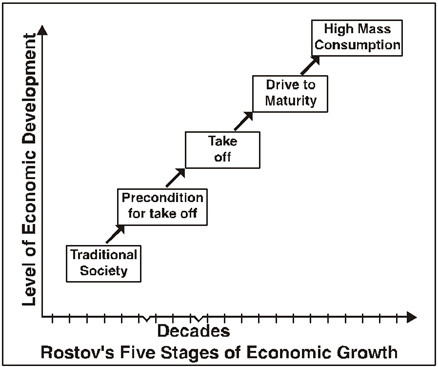
Each country, according to Rastov’s structure, can be allocated to one of the five stages, as shown in the figure given here. The United States, for example, was in stage 1 during the colonial era, stage 2 during the first half of the nineteenth century, stage 4 untill the early twenteeth century and stage 5 since then.
While many of Rastov’s criteria for each stage are arbitrary, the model suggested to leaders of less developed countries priorities for investment in the economy.
Critical Evaluation: On the question, whether Rastov’s model single out crucial variables, the model comes out with flying colours. In stressing, for example, the role of ‘leading sectors’ (i.e. economic activities which exhibit high growth rates and from which growth is transmitted to other parts of the economy), of agriculture and the provision of social overhead capital during early stages in growth and of a growth oriented political and social framework. Rastov does appear to have focussed attention on variables judged very important by the economists.
Rostov’s optimistic projection was based on two factors:
(i)The relatively developed countries of Western Europe and Anglo-America have been joined by others in East Europe and Asia.
(ii)Many developing countries contained an abundant supply of raw materials which can be used to generate take off stage. The most notable example has been the development efforts ofS.W. Asian countries using revenue from oil-exports.
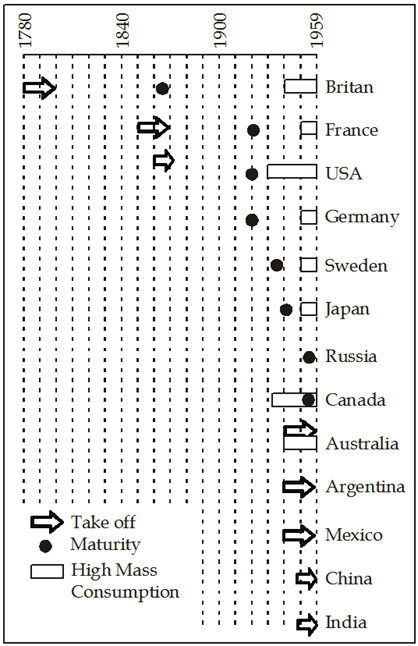
But two fundamental obstacles come in the way of Rastov’s optimism:
(i)Resource Distribution: There is uneven distribution of resources among developing countries, which is causing many social and political problems. Moreover, the prices of their raw materials did not increse as rapidly as the cost of industrial products imported from developed countries.
(ii)Market Stagnation: Developed countries have limited growth in population and in turn market size. Developing countries must generate market at home or in other developing countries.
Some developing countries reject Rastov’s development model and some of them including China and India have adopted a self-sufficiency approach. Thus, instead of concentrating on a few take-off industries, they may profit more in the long run by adopting a balanced approach to growth.
Rastov’s model is criticized on the count that it simply fails to specify any mechanism which link the different stages. Moreover, most economic historians deny that the histories of present day advanced countries reveal any signs of a twenty to thirty year period in which, investment rate rose sharply denoting the take off. And empirical observations have thrown serious doubt on the very separateness of Rastov’s different stages.
Whatever the final verdict on the model, it must be admitted that it has stimulated an enormous amount of research into regularities in economic growth. It might well be valuable and illuminative as a teaching device, for comparing and classifying apperently different economics.
Q7. To what extent do the regional patterns of economic development and human development in the world correspond with each other? Highlight situations of departure, in particular. (2002)
Answer:
Since the advent of human on the planet earth, they have been lying to improve their economic lot with their socio-cultural and technological tools. From wild nuts and fruits to chicken-Biryani, from mud hutments to multistoried airconditional building. But, such development shows a lopsided character and many flock of people and regions have fallen short of even fulfilling their basic needs.
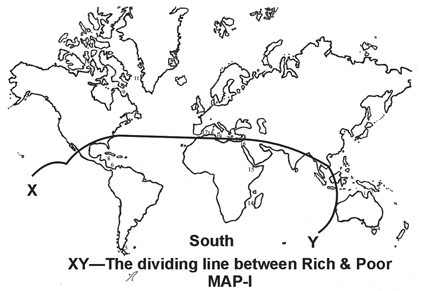
Such disparity in development can be seen at three levels:
- Inter Regional/State desparity.
- Intra Regional/State disparity.
- Inter Personnel disparity.
By inter-regional disparity, we mean the difference in economic well being across regions. For e.g. the North & South division of the world. The North being developed in terms of economic, technological, human and social indicators and South as a laggard in all these respects. The primary reason for this developmental gap was that the South was colonised by the superior military powers of the North and their resource and man power was exploited for the benefit of the North.
Economic development of a region is measured in terms of gross domestic product, per capita income, per capita consumption, export earning etc. These indicators are generally very high for the developed nations and very poor for the underdeveloped and the developing nations.
Human development signifies the overall development of personality and his status as a human. Its chief indicators are longevity, literacy, nutrition level, sanitation, healthcare, food security, etc.
The observed pattern on the globe is that the economic development and human development are co-terminus. The economically developed countries also show a better trend in human development.
Map-II shows the different regions of the world in terms of economic development.
(A)The highly developed group will comprise
- The Anglo-America-Canda & USA
- West Europe— The Scandinavian, Great Britain, France, Germancy. etc.
- Anglo-Oceanic Region—Australia & New zealand.
- South Africa.
- Far East Region—Japan
(B)The moderately developed/developing region will include—
- Russia and other CIS countries
- Eastern Europe—Poland, Romanic, Bulgaria, etc.
- China
- South East Asian Giants, India, Srilanka.
(C)The poorly developed countries will include—
- the Sub-Saharan countries
- African countries other than South Africa
- Latin America
- South Asian countries like Bangladesh, Pakistan
- Myanmar, Laos, Combodia etc.
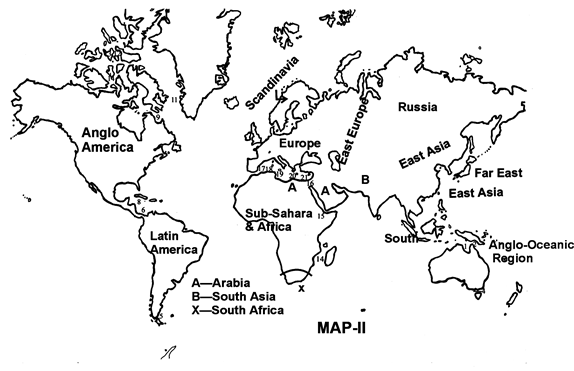
The above division brings out the spatial pattern of economic development over the globe. Human development almost coincide with this division for, e.g. The Scandinavia, Canada, Switzerland, which have less of population are always rated very high on the Human Development Index. US, Great Britain, Australia are not doing bad as well.
But there are cases, where we see a clear departure from this abovesaid notion. The example of Middle east can be quoted to show that despite high per capita income and Gross Domestic Product (GDP) of the Arabian countries, they show rather poor trends in terms of human development. The reason is purely cultural and religious and to some extent geographical in as much as a the climatic and terrainic hazards are added.
The case of China is also mentionable. China in recent years has emerged as a big economic giant but the lot of the people is still needed to be impressed.
In India, the trend is also reverse. On the one hand, economically poor state Kerala shows the best performance on Human Development Index (HDI) list, on the other hand, Haryana and Punjab, the most developed states have poor performance on Human Development Index (HDI).
Thus, it can be summed up that the arcal pattern in economic development do coincide with the human development, become money can buy the amenities and facilities, but this cannot be the rule. Human development is also affected by socio-cultural reason, government policies, awareness, education, etc.
Q8. Bring out the main points of difference between the central place theories of Christaller and Losch. (2002)
Answer:
Central place theory is a normative deductive theory based on certain simplifying assumptions. It is concerned with the discovery of order in size and spacing of population cluster and settlements in the landscape.
It envisages a hierarchical structure of settlement with seven or more levels in a meso region with a metropolitan city at its apex.
It was propounded by Christaller in 1933. This theory is based on two fundamental principles—Principle of centralisation and Principle of hierarchy and six derivative concepts namely:
(1) Central places which is an area providing services to the hinterland known as (2) Complementary area supplying it with (3) Central goods & services such as administrative banking and professional services, entertainment as well as those of retail and whole sale trade. (4) Range of goods is the maximum distance that a consumer is willing to travel in order to buy a specific good. Each goods will have its own characteristic range. The minimum number of customer required to support the offer of a central goods or services (5) threshold. (6) Centrality of a central place is defined as the ratio between the services provided and the local needs of its inhabitants.
The substantive part of the CPT consists of a set of proposition that explain the nature of relationship between central places, their complementary areas and the hierarchical system of settlement. The proposition are normative in character and are based on a number of efficiency and optimality criteria.
- Isotropic surface (uniform with respect to terrain climate resource, population distribution and income level of the people).
- The shape of complementary area to be hexagonal, so as no area remain unserved or doubly served.
- Number of central places—The optimality of central place is seen from the point of view of efficient distribution of goods and services to the population. The cost of distribution is minimised in this system by having a minimum number of central places.
- Hierarchical levels—Shall also be minimum for the sake of efficiency. This can be made possible by accomodating the maximum number of functions at each hierarchical level, where higher order central places should also function as lower order centres.
- The pattern of nesting—For each hierarchical level of central places, there is a corresponding network of hexagonal complementary area. The lower order hexagonal networks nest within the higher order networks. Since, they cover the some territory.
The geometrical pattern of nesting is determined by certain optimality consideration Christaller envisages three such criteria.
a.The marketing principle, which assume that the number of eps of lower order would be minimum required in relation to the number of places of immediate higher order and the lower order central places should lie as close as possible to the immediate higher order. It can be shown by a diagram and a variable K which is valued 3.
If, Tehsil is taken as x
The complementary area of district
= x + 2x = 3x
Thus, hierarchy will be in the order of 1, 3, 9, 27…….. and K = 3.
(b)Transport Principle, involves the minimisation of road length to minimize the transportation cost.
= 4×
K = 4
Size of complimentary area of the lower and higher one will be in the ratio of 1, 4, 16, 64……
(c) Administrative Principles, emphasizes the notion that complementarity of lower order, centres should be entirely within the limits of the complementary area of next hirarchical order.
Here, the ratio will be in the order of 1, 7, 49, 343….
K = 7
The system of central places is not a static arrangement, but respond to changes occuring in society and economy CPT is more applicable to matured economics, where tertiary functions are overwhelming, which have evolved over a period of time but not imposed by some authority.
Augurt Losch, introduced a different scheme to explain the structure of regions and spacing of settlements based upon Christaller model of hexagonal service area.
He introduced the following into Christallers model.
(a)More variation in threshold sizes.
(b)Several K values in one central place system.
(c)A greater variety of central places.
(d)Towns having difficult sphere of influences for different goods and services.
Losch regards the K values as being free to vary and in his general care, Christaller’s K values (3, 4, 7) become only particular cases of a large number of possible hexagonal systems. Thus, Losch model is even more complex and elaborate.
The market areas of different goods resemble nests of hexagons as in Christaller theory. Assuming the K values to vary widely for different types of goods and services, there could be a large number of hexagonal pattern (for about 150 different sets of goods & services). If all these networks are superimposed upon one another with atleast one centre in common, a metropolis will arise.
If the entire set of hexagonal network is rotated one by one around this common centre, so as to make the largest number of hexagons to overlap and if, this is achieved, the final pattern will have 12 sectors with ulternating city rich and city poor sectors.
Losch different from Christaller in as much as he said that the centres in the same hierarchy may produce quite different combinations of goods.
Christaller begins his hierarchy from highest centre, such as metropolis. Losch did the reverse by begining at the lowest level of hirarchy.
Christaller did not consider the existence of specialised production centres. But Losch considered it.
The Christaller model gives a better understanding of retail business and services, while Loschian model explains the spatial distribution of market based manufacturing.
The farmers pattern best suited for understanding those centre which developed in sparse settlement regions, while Losch theory is for densely populated region.
Q9. Discuss the concept and application of system analysis in Human Geography. (2001)
Answer:
A system consists of a set of entities with specification of relationships between them and their environment. The study of system, therefore, appears to be associated with the study of complex structures. Geographers have used forms of systems concepts, since the dawn of the subject. However, no methods and techniques had been developed to enable the analysis of complex system in an accurate way before Second World War when systems concepts were invoked in descriptive contexts with particular reference to consideration of a balance in nature.
System analysis is a methodological framework for investigating the structure and function of a system. The keystone of the study of system is connectivity. A system comprises the three components—(1) a set of elements (2) a set of links or relationship between those elements and (3) a set of links between the system and its environment. Every system has three basic aspects : structure, function and development. The structure is the sum of the elements and connections between them.
The concept of system approach in geography is based on general system, which was first of all developed by a biologist Ludwing Von Bertalangffy. It is based on the assumption that the elements of a particular biotic form or shape functions in close integration and interelation. Geography is a dicipline where inter-relations and integration have been found in various spheres of its subject matters. This also involved a set of concepts which offered the prospect of a theoretical integration of Physical and Human Geography. The use of system analysis is based on the assumption underlying much positivist work in human geography, that valid analogies can be drawn between human societies, on the one hand and both natural phenomena complexes and machines on the other. Individual elements in a system have pre-determind roles and can act and change in certain restricted way only, depending on the structure of the system and its interrelationships with the environment.
Humboldt has defined modern geography as a dicipline of relation and has suggested system approach for its explanation. Present system approach is basically the revival of the work of Humboldt. Physical and human factors maintain close level of integration and interrelation. They need to be explained. In modern geography, system approach was first brought by Minshall through his book “Changing Nature of Geography”. He defined system approach as any group of phenomena which have a functional relationship or they operate togather as a complex whole. This type of approach was further developed by Chorley, Hagett, Harvey and several others. Blalock and Blalock in 1959 have given a model to explain the nature of integration and interrelation. According to them, system approach is an attempt to explain geographical facts and figures not only in a particular complex whole but also to explain the integration and interrelation of the whole in a hierarchial order. For example, transport system of a city may be a complex whole in isolation but this system is the very much a part of the complex transport system of the country. Hence, transport planning of a city must understand the transport system of the entire country rather the system of city.
Chorley and Canady had suggested that geographical system can broadly be of two types—functional system and structural system. Functional approach is more helpful in human geography and particularly to explain functions and behaviour of society. Structural system is also used in human geogrpphy but it is more helpful in explaining the physical system or layout of a region.
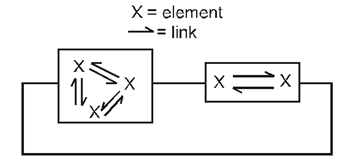
Functional system is further sub-divided into four categories :
(1) Isolated System : It is that system where the society maintains no linkage with other societies. This situation is found in most of the tribal societies of the world. They have tendency to maintain isolation. Hence, the system approach may explain in better way about the causes of isolation.
(2) Open System : It is that one where the society is ready to integrate in any society, which is based on scientific reasons. The human system of developed country can be explained properly by this approach.
(3) Close System : It is rarely in geography. There are few people of central Africa and Andaman & Nicobar in India, who have close system.
(4) Semi-Close System : It is that, where two societies are making integration on the limited scale. This is useful for the explanation of socio-economic system of most of the developing countries.
Structural System is also divided into four sub-types :
(1) Morphological System : It is that one which explains built up pattern. This is useful in explanation of rural and urban morphology.
(2) Cascading System : It is that one, in which output in one system becomes the input of next order system. This approach is very useful in the study of industrial landscape. Industrial complexes can be explained through this approach.
(3) Process Response System : It is that, in which, process itself makes a system. For example Green Revolution region in India has a process of change.
(4) Controlled System : No system can be allowed arbitrarily. There is a control of environment. Hence, all developmental study is carried under head of controlled system and one must study the impact of environment on industry as controlling factor. If such factor is ignored, environment of industry is controlling factor. If such factor is ignored, environmental disaster will occur.
Thus, the present geography is able to adopt system approach in various field of explanation. This approach is more useful in human geography.
Q10. Examine the theories about population control and explain the relative merits of these theories in limiting population growth. (1995)
Answer:
Though the history of vague thinking on population resource nexus dates back to the days of Plato, yet Thomas Robert Malthus was the first person to systematize information regarding this matter. He undoubtedly was the first scholar to propound a population theory based on his natural law.
Malthusian Theory of Population Growth: Malthus published ‘An Essay on Principle of Population’ in 1798 and it is to his ideas that the subsequent thinking on the economic approach to demography may be traced. He was of the view that population tends to increase faster than means of subsistence.
The fast growth in population absorbs all economic gains unless controlled by what Malthus termed as ‘preventive’ and ‘positive’ checks. He suggested that population, if unchecked, tended to increase at a geometric rate (i.e. 1, 2, 4, 8, 16,………) while subsistence increased at an arithmetic rate (1, 2, 3, 4, 5,……). The population doubles after every twenty-five years.
Malthus believed that two of men’s characteristics essential to the maintenance of life were immutable, were laws and were antagonistics.
(i)the need for food, and
(ii)the passion between the sexes.
The widening gap between population and subsistence will increase a man’s tendency to press upon the means of subsistence. With the result, the society gets divided into two sets of people-the rich and the poor-giving rise to capitalistic set up. In the opinion of Malthus, the increasing gap between the population and resources shall ultimately lead to the point where misery and poverty shall become inevitable.
Malthus did believe that preventive checks such as delayed marriage, moral restraint, etc. would so reduce man’s rate of production that the positive checks would not operate continuously. The positive and preventive checks which occur in human population to prevent excessive growth relate to practices affecting mortality and fertility respectively. So his positive checks included wars, diseases, poverty and especially lack of food while his preventive checks included principally moral restraint or the postponement of marriage and ‘vice’ (adultery, birth control& abortion). Malthus stressed the negative correlation between station in life and number of children and in order to induce in the lower classes the self-control and social responsibility which he saw in the middle classes, he assested that the poor should be better paid and educated-an idea which is still recognized as one of the most effective method of population control.
The Malthusian theory is criticized on the following counts:
(1)Malthus over-emphasized the ‘positive’ checks and did not visualize the role of preventive checks like contraceptives and family planning.
(2)There is no casual relationship between positive checks like poverty, war, diseases etc. and overpopulation.
(3)The validity of his two sets of ratios (i.e. geometric and arithmetic) and population – doubling period of 25 years has also been questioned.
(4)Malthus has been severely criticized for ignoring the role of changing technology and the consequent transformation in socio-economic set-up ofa society.
In spite of all these criticisms, Malthusian principle of population has been successful in highlighting the urgency to maintaining a balanced relationship between population and means of subsistence. He might appear premature in certain respects but he contributed largely in bringing the study of population into the fold of social sciences.
Sadler (1780-1835): Another scholar, M.T. Sadler found an inverse correlation between man’s tendency to increase in numbers and density of population. The population would cease to grow beyond a point where it had secured the utmost degree of happiness for the largest possible number of human beings.
Spencer (1820-1903): Like sadler and Doubleday, Herbert Spencer believed that there was a natural law that would absolve man from any responsibility for the control of his increase in numbers. The nature shall achieve this end by weakening man’s interest in reproduction while leading him to devote more and more timeto personal, scientific and economic developments.
However, it is difficult to find any conclusive evidence about he existence of natural law governing man’s fecundity over which the man has no control.
Social Theories of Population: Among the social theories are included H. George, A. Dumont, P. Ricardo and Karl Marx. George strongly advocated that unlike other living things, the increase in man’s numbers involved the increase in his food as well. A. Dumont gave his ‘theory of social capilarity’, considering upward movement of individuals in society from class to class as a direct cause of decline in birth rate, because according to him the development of numbersin a nation is in an inverse ratio to the development of individuals. D. Ricardo strongly believed that population regulated itself according to the availability of funds to employ it. Hence, the population increases or decreases in accordance with increase or decrease of the rate of capital formation.
Karl Marx (1818-1883), following a dialectical approach, considers the society to consist of two major classes-the rich and the poor. The profit earned by the rich led to the process of capital accumulation with the rich. In response to this, the poor labour class tries to accumulate labour, through the rapid population growth. This is a law of population peculiar to the capitalist method of production.
According to Marx, poverty and misery were not natural inevitabilities but were the evils of capitalism which will disappear if his system of communism was adopted. Marx pleaded for technological change that could increase the productivity of labour and could yield marvellus economic benefits. He recommended a system’s approach to the entire problem.
Thus, unlike natural theorists, social theorists pleaded that population growth was determined by man’s inherited characteristics as developed in the total milieu in which he lives. Social theories are believed to be working right direction, though these too do not offer any panacea for all ills.
In case you still have your doubts, contact us on 9811333901.
For UPSC Prelims Resources, Click here
For Daily Updates and Study Material:
Join our Telegram Channel – Edukemy for IAS
- 1. Learn through Videos – here
- 2. Be Exam Ready by Practicing Daily MCQs – here
- 3. Daily Newsletter – Get all your Current Affairs Covered – here
- 4. Mains Answer Writing Practice – here

